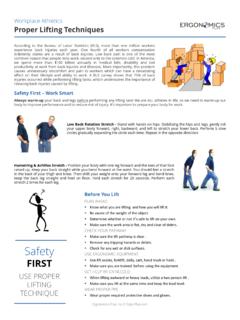Transcription of DEVELOPING PATIENT EDUCATION HANDOUTS
1 Thomas A. Lang DEVELOPING PATIENT EDUCATION HANDOUTS 1 DEVELOPING PATIENT EDUCATION HANDOUTS Thomas A. Lang Tom Lang Communications INTRODUCTION In recent years, patients have increasingly requested the opportunity to participate more fully in their medical care. An important part of responding to this request is the production of educational HANDOUTS that inform patients about health problems, describe medical treatments, and promote healthy behaviors. DEVELOPING effective PATIENT EDUCATION HANDOUTS is often difficult.
2 Many caregivers have neither the time nor the training to write and design them. Even writers schooled in English or journalism may find that they are unprepared to write instructions that patients must understand thoroughly and follow closely and that may be read in several different circumstances. Grammatically correct sentences are not enough; writers must be creative, flexible, and sensitive in their use of language, illustrations, and graphic design to address the variety of audiences and uses of such HANDOUTS . Conventional HANDOUTS usually record descriptive information about diseases or reiterate the advice given by caregivers.
3 As such, they are useful extensions of spoken communication. However, increased understanding of how readers make sense of written texts, how notions of "reality" are created and maintained, and how behaviors can be influenced have resulted in the possibility that PATIENT EDUCATION HANDOUTS can be effective enough to be thought of as a form of what is being called bibliotherapy. To produce HANDOUTS that can be therapeutic in their own right, writers need to adapt a new orientation to their task, become familiar with a new body of knowledge, and master a new set of skills.
4 Thus, in this booklet I describe how to develop effective PATIENT EDUCATION HANDOUTS . (I've used the term "handout" here because I've limited the discussion to written, printed materials.) I discuss the qualities of effective HANDOUTS and present several techniques to enhance these qualities. I also suggest a series of tasks for producing HANDOUTS efficiently and for evaluating their effectiveness with patients . Thomas A. Lang DEVELOPING PATIENT EDUCATION HANDOUTS 2 Thomas A. Lang DEVELOPING PATIENT EDUCATION HANDOUTS 3 WHY ARE PATIENT EDUCATION HANDOUTS IMPORTANT?
5 PATIENT EDUCATION HANDOUTS are important because: They are an extension of medical care and can affect its quality. The primary purpose of PATIENT EDUCATION HANDOUTS is to improve patients ' health and quality of life. Effective HANDOUTS should thus improve adherence to prescribed behaviors by changing or reinforcing patients ' knowledge, skills, values, or choices related to their health. Spoken messages are forgotten quickly and so need to be reinforced with informative HANDOUTS . The facts in a spoken message are quickly lost and reinterpreted.
6 Well written HANDOUTS counter this loss and reinterpretation by reducing the need to remember spoken instructions and to guess at forgotten meanings. patients form opinions about their caregivers from PATIENT EDUCATION HANDOUTS . HANDOUTS communicate both a message (the instructions patients should follow) and a "meta-message:" how important the message and the patients are to the caregiver. Thus, well written, attractive HANDOUTS say, "This information is important to you [and by implication, so are you]." The message and meta-message also have important marketing implications for the institution.
7 WHAT MAKES EFFECTIVE HANDOUTS ? Well prepared HANDOUTS are: Easily accessible. Information can be made more accessible by including it on items patients already use regularly: calendars, bookmarkers, wallet-size reference cards, and so on. A handout whose only function is to inform patients may be easily put aside and forgotten; a handout with additional functions can keep the information close to its intended audience. Appropriate for patients ' needs. HANDOUTS should enable patients to respond to specific health needs by providing information that is necessary and sufficient to direct and to promote patients ' self-care.
8 Also, many patients appreciate a list of additional readings on the topic. Easily understood. Instructions that are easy to understand are more likely to be read and more likely to be followed. Compatible with the patients ' values and lifestyles. Insofar as possible, HANDOUTS should appeal to patients and not offend them. (The intent is not to spare patients from the truth but to avoid making the communication unnecessarily confrontational.) Thomas A. Lang DEVELOPING PATIENT EDUCATION HANDOUTS 4 Compatible with other information given to the PATIENT .
9 HANDOUTS are most effective when they support and are supported by other forms of communication, such as one-on-one teaching, audiovisual programs, and other reading materials. Conflicting information confuses patients and is thus counterproductive. Easily remembered. Understanding is often not enough; patients may have to recall their instructions before they can follow them. Easily referenced. Information that is not or cannot be remembered should be easy to find in the handout so that it can be read again when necessary.
10 Visually appealing. Well designed and illustrated HANDOUTS enhance the above characteristics and impart the meta-message that the information they contain is important. Efficiently and economically prepared. HANDOUTS should be created through a process that results in a timely, well conceived, and quality product and that avoids unnecessary delays, confusion, and costs. WHAT CAN HANDOUTS ACCOMPLISH? Educational HANDOUTS are only a small part of the communication patients receive from health care providers.






